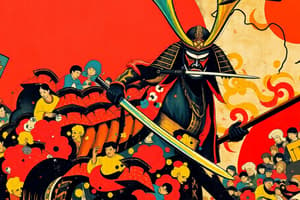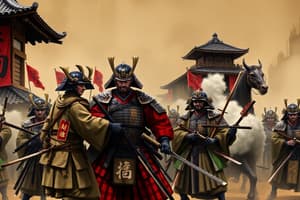Podcast
Questions and Answers
What was the primary role of samurai in Feudal Japan?
What was the primary role of samurai in Feudal Japan?
- To serve the daimyos and shoguns (correct)
- To engage in trade and commerce
- To govern the country
- To serve the emperor directly
What was the basis of the Shogunate's power?
What was the basis of the Shogunate's power?
- Popular election
- Divine right
- Control of land and resources (correct)
- Control of the imperial court
What was the primary economic system of Feudal Japan?
What was the primary economic system of Feudal Japan?
- Feudalism (correct)
- Mercantilism
- Capitalism
- Socialism
What was the primary influence on Japanese culture?
What was the primary influence on Japanese culture?
What was the social hierarchy of Feudal Japan?
What was the social hierarchy of Feudal Japan?
What was the role of the daimyos in Feudal Japan?
What was the role of the daimyos in Feudal Japan?
What was the primary purpose of the traditional Japanese tea ceremony?
What was the primary purpose of the traditional Japanese tea ceremony?
What was the primary reason for Japan's reliance on imports during the Feudal period?
What was the primary reason for Japan's reliance on imports during the Feudal period?
What was the focus of a geisha's training?
What was the focus of a geisha's training?
What was the social status of geisha in Japanese society?
What was the social status of geisha in Japanese society?
What was the primary reason for the decline of the geisha tradition in the 20th century?
What was the primary reason for the decline of the geisha tradition in the 20th century?
Flashcards are hidden until you start studying
Study Notes
Samurai
- Warrior class in Feudal Japan (12th-19th centuries)
- Code of honor: Bushido ( Rectitude, Courage, Benevolence, Respect, Honesty, Loyalty, Self-discipline)
- Skilled in martial arts, sword fighting, and archery
- Served as vassals to daimyos (feudal lords) and shoguns
- Loyal only to their lord, not the emperor
- Expected to maintain honor and prestige through bravery, loyalty, and self-discipline
Shogunate
- Military government of Feudal Japan (1185-1867)
- Established by Minamoto no Yoritomo, first shogun
- Shoguns held absolute power, controlled the emperor
- Bureaucracy: shogun, daimyos, samurai, and peasants
- Shoguns maintained power through:
- Control of land and resources
- Military strength and strategic alliances
- Isolationist foreign policy (Sakoku)
Economic Systems
- Feudalism: lords granted land to vassals in exchange for loyalty and military service
- Agrarian economy: rice, tea, and silk production
- Trade:
- Domestic: regional markets, merchants, and artisan guilds
- Foreign: limited, mainly with China and Korea
- Currency: gold, silver, and copper coins
- Taxes: rice, goods, and labor
Culture
- Influenced by:
- Buddhism (imported from China and Korea)
- Shintoism (indigenous religion)
- Confucianism (imported from China)
- Art and Literature:
- Ukiyo-e woodblock prints
- Haiku poetry
- Noh theater
- Architecture:
- Castles and fortifications
- Temples and shrines
- Traditional houses (minka)
- Social Hierarchy:
- Emperor and court nobles
- Shoguns and daimyos
- Samurai and warriors
- Peasants and artisans
- Merchants and artisans ( lowest social class)
Samurai
- Developed in 12th century, flourished until 19th century
- Followed Bushido code of honor, emphasizing Rectitude, Courage, Benevolence, Respect, Honesty, Loyalty, and Self-discipline
- Skilled in martial arts, sword fighting, and archery
- Served as vassals to daimyos and shoguns, with loyalty only to their lord
- Honor and prestige were maintained through bravery, loyalty, and self-discipline
Shogunate
- Established in 1185, lasted until 1867
- Founded by Minamoto no Yoritomo, the first shogun
- Shoguns held absolute power, controlled the emperor
- Shogunate bureaucracy consisted of shogun, daimyos, samurai, and peasants
- Shoguns maintained power through:
- Control of land and resources
- Military strength and strategic alliances
- Isolationist foreign policy (Sakoku)
Economic Systems
- Feudalism: lords granted land in exchange for loyalty and military service
- Agrarian economy based on rice, tea, and silk production
- Domestic trade: regional markets, merchants, and artisan guilds
- Foreign trade: limited, mainly with China and Korea
- Currency: gold, silver, and copper coins
- Taxes: rice, goods, and labor
Culture
- Influenced by Buddhism, Shintoism, and Confucianism
- Art and Literature:
- Ukiyo-e woodblock prints
- Haiku poetry
- Noh theater
- Architecture:
- Castles and fortifications
- Temples and shrines
- Traditional houses (minka)
- Social Hierarchy:
- Emperor and court nobles
- Shoguns and daimyos
- Samurai and warriors
- Peasants and artisans
- Merchants and artisans (lowest social class)
Feudal Japan
- Feudal Japan's social hierarchy featured the emperor at the top, followed by the shogun, daimyos, samurai, farmers, artisans, and merchants.
- Both Buddhism and Shintoism coexisted, with Buddhism introducing new ideas and Shintoism connecting to indigenous traditions.
- The era saw the development of literature, including "The Tale of Genji," and art forms like ukiyo-e woodblock prints and sumi-e ink painting.
- The traditional Japanese tea ceremony emphasized mindfulness, simplicity, and harmony with nature.
Japanese Geography and Economy
- Japan is an archipelago of over 6,800 islands, featuring a rugged terrain and a climate ranging from subtropical to temperate.
- Rice was the primary crop, with most farming done on small, family-owned plots using irrigation systems and terracing.
- Japan had limited natural resources, including iron, copper, and silver, leading to a reliance on imports and careful resource management.
Geisha Tradition
- The geisha tradition emerged in the 17th century, with the term "geisha" meaning "artist" or "performer."
- Geisha were trained entertainers providing music, dance, and conversation to wealthy patrons in teahouses and private residences.
- Geisha underwent rigorous training in music, dance, poetry, and etiquette, focusing on developing skills and beauty.
- Geisha occupied a unique position in Japanese society, being both admired for artistic talents and ostracized for perceived immorality.
- The geisha tradition declined in the 20th century due to Westernization and changes in Japanese society.
Studying That Suits You
Use AI to generate personalized quizzes and flashcards to suit your learning preferences.




